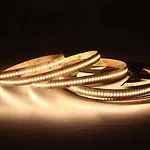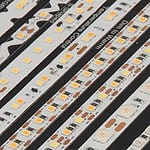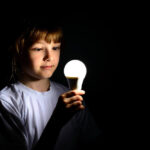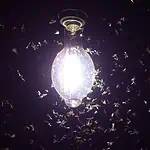LED lights are the most popular lighting technology at present, but are they safe for dogs? Or are dogs’ eyes equally sensitive to light as human eyes? As a dog owner or lover, you must know details about LED lights to keep your dog’s eyes.
Well, as long as LED lights lack UV rays, they are safe for dogs. Dogs feel less sleepy around blue LED lights, whereas they feel more comfortable with red LEDs as they have less intensity. Although dogs can’t see any specific colors like us, they can get disturbed by flickering lights. It’s best to purchase quality LED lights with a dog-safety logo. Yet, the preference differs from dog to dog, so you need to keep an eye on them and decide which color they find comfortable.
Being a pet lover, I find it essential to understand how dogs feel about LED lights and specific colors. In this article, I will share everything you need to know about LED lights to find out whether it is hurting your dogs. So, let’s get started–
Can LED Lights Harm Dogs Eyes?
My direct answer would be no; LED lights do not harm a dog’s eyes. Usually, in normal situations, they are safe for dogs. But when your lights flicker, or pets stay under the LED light for a long time, it can hurt their eyes. Besides, excessive exposure to the blue light emitted by LEDs can be problematic for dogs, affecting their circadian rhythm like humans. The potential harm to dogs’ eyes mirrors the impact on human eyes. Therefore, humans and dogs can suffer damage from prolonged exposure to excessive blue light.

Types Of LED Lights That Are Safe For Dog Eyes
You will find two types of LEDs that are safe for dog eyes. These are as follows–
1. Dog-Safe LED Lights
These LED lights are specifically designed for dogs’ eyes. These fixtures are labeled as ‘dog-safe’ or ‘pet-friendly.’ They come with a wider beam angle and lower intensity, reducing eye stress on dogs.
2. Red LED Lights
Red lights are also safe for the dog’s eyes as they contain little intensity. Also, these lights do not shine like other kinds of LED lights. Red has a longer wavelength than other colors, and it tends to be less harsh on sensitive eyes. Additionally, red light may be less disruptive to a dog’s natural circadian rhythm.
Advantages & Drawbacks Of Using LED Lights For Dogs
There are many benefits to using LED lights for dogs, and the cons are few. Let’s see some of these here–
Pros
Calming Light
When your dogs get nervous sometimes, you can create a sleep-inducing, calming environment using LED lights. This is achieved through amber and orange-enriched, extra-warm white light, which is scientifically proven. And it is specifically beneficial when the dogs can be left alone for a long time.
RGB Colored Lighting
With RGB strip lights, you can combine a wide range of colors. It is a fantastic tool to make moods and customize lighting in the house. Although research found that dogs perceive colors differently than humans, they still appreciate the mix of colored light. Dogs can recognize changes in lighting levels, so colored LED lighting is beneficial for setting the mood for them.
Smart LED
Using smart LED lighting, you can remotely change the light’s brightness, color, and even times when it needs to turn off or on. For instance, suppose you need to leave your pets at home alone for an extended period. You can turn on the lights through a phone app while driving home or visiting somewhere. Also, you can connect the PIR motion sensor to the LEDs to switch on the lights automatically when the dog enters every room.
Cool To Touch
LED lighting provides less heat than traditional lights, which is much safer for pets. There is always some risk of buns using incandescent lighting as it generates heat and tends to get hot. Therefore, you can set LEDs at lower levels to design better lighting without worrying about burns.
Cons
Eye Damage
The most common drawback of LED lights is they can damage dogs’ eyes when you do not purchase dog-safe lights. It can lead to vision problems and even blindness.
Skin Burns
If your LEDs are not dog-safe, they can cause skin burns. This happened with direct contact, so it’s essential to be aware of it.
Fire Hazard
Buying LEDs without considering dog safety can lead to a fire when dogs damage the cords easily. For instance, if you have built a dog house with an insulated ceiling, ensure the fixture you use is IC-rated. This will save your dog from fire risks. To learn details, check this- IC Vs. Non-IC Rated Recessed Light Fixtures.

When Can LED Lights Hurt Dogs’ Eyes?
Although LED lights are designed to be safe for dog’s eyes, there are a few circumstances where these lights can create problems for dogs. For example–
Flickering Light
LED lights do not flicker much like fluorescent bulbs. Yet cheap quality LEDs can have this issue. Repetitive and rapid light flashing can cause discomfort for the dog’s eyes. Occasionally, excessive exposure can cause some significant problems. And the flickering lighting can trigger seizures in dogs with epilepsy. This leads to various neurological problems. It occurs due to the heightened stimulation of the visual cortex in the brain caused by the rapid flashing. The neurological impact of light flickering is not exclusive to dogs; it also affects humans. For more information, please check Why do LED Lights Flicker on Video?
Direct Staring
Purchasing items from a well-known LED light manufacturer guarantees safety. Nevertheless, ensuring that your dog does not consistently gaze at a highly luminous LED light is essential. Besides, industrial lights and automotive headlights can irritate and permanently damage dogs’ eyes. So, you have to ensure your pets do not get exposed to such lights for a long time. Furthermore, your pet should have a designated space shielded from direct exposure to light. Additionally, it is advisable not to position the dog’s bed directly under a light fixture.
Improper Use Of LED Toys
LED dog toys are becoming more popular among customers. These toys are made for throwing and catching and have blinking lights to catch a dog’s attention. However, these toys can sometimes not be suitable for a dog’s health. So, if you decide to get one, ensure it’s safe for your pets.
UV Light
Certain LED lights might give off a tiny bit of UV light. The coating on the LED chip usually stops most of it. But, some blue LED lights could still release a small amount of UV. Even though these lights are generally safe for your dogs, if you want to be extra careful, it’s better to avoid them. For more information, please check Do LED Lights Emit UV Rays and Radiation?
Blue Light Spectrum
Like humans, a dog’s eye can get harmed and negatively impacted by blue light disclosure. In simple terms, blue light has a shorter wavelength than other colors in the light we can see. This means it can go deep into our eyes. Because of this, it can impact the health of cells in the back part of our eyes, called the retina. This situation is called blue light toxicity. Therefore, staying around blue light for a long time might make your eyes uncomfortable. Sometimes, it could even lead to trouble seeing, red eyes, and swelling, but this doesn’t happen often. How much it can bother your eyes depends on light intensity and how long you’re around it. In addition, similar to humans, dogs have circadian rhythms, which give their body information on when to get up and sleep. And it is run by sunlight. Like the Sun, blue lights function similarly. So, when your dog stays under blue light, it can feel depressed and restless. More specifically, blue light can break a dog’s nocturnal habit.
Also, studies suggest that extended exposure to blue color can affect a dog’s mental and physical health. But the best thing is that LED lights offer negligible blue light compared to conventional lamps. However, you need to follow a particular bedtime routine for the dog. And remember, the brightness of lights should not be harsh at bedtime. Therefore, you can also take the dog for a walk before bedtime. If you want to use lights in your dog’s place, pick lights with longer wavelengths. For instance, amber or orange lights have longer wavelengths than your eyes can see.
Pre-existing Eye Conditions
You must be more careful when your dog has a pre-existing eye problem, cataracts, or corneal ulcers. Such conditions are more sensitive to damage by the LEDs.

Tips To Choose LED Lights For Dogs
You need to purchase LED lights for dogs wisely to ensure their well-being and safety. Check some features to think about while selecting LEDs for dogs mentioned below–
Low Blue Light Emission
As mentioned above, prolonged exposure to blue light can create eye strain and discomfort. So, it’s best to use LEDs with low blow discharge. Nowadays, LEDs provide a small quantity of blue light as they contain filters to reduce the blue light’s brightness and screen protectors.
Use Dimmable LED lights
You can use dimmable LED options to adjust lights to create a comfortable atmosphere for your dog’s eyes, particularly at night. Also, using LED strips can improve the surroundings of the dog’s shelter. Therefore, with a dimmable option, you can customize the brightness of the LED strips. For more information, you can check How to Dim LED Strip Lights.
Create a Cool Environment Inside Your Dog’s Shelter
You can try warm white and amber for a calming effect, as they can mimic sunlight and provide fantastic visibility. Amber and orange lights are famous for offering a relaxing atmosphere. Therefore, as a homeowner, you need to know to ignore night lights. Otherwise, it will make your dog’s eyes start to stare.
Use Smart LED Lights
While choosing smart LED lights, you can consider these remotely with the help of a phone app. This way, you can adjust the brightness and color where they are. Certain lights have a particular sensor that turns on when a dog comes close. It’s easy to connect an LED light to a phone. So, you can use Bluetooth or Wi-Fi. Just follow the instructions from the company to pair them correctly.
Invest In Quality LEDs
Choose good LED lights to stay safe. Get them from a trusted and experienced maker. Look for certificates that show the lights are safe and good quality. Thus, always make sure the lights you buy are certified for safety.
Install Light Accurately
When installing LED lights inside the dog house, always keep in mind the height of the house. Don’t end up mounting a bulky fixture in the small pet house. It is better to hire a professional to install built-in fixtures in the house so there are no hanging lights that could harm the dogs while they move. Also, be careful about proper wiring.
Consider These Before Purchasing LED Lights For Dogs
When you are unsure whether LED lights are safe for the dog or not, you can check a few factors–
- Look For The Dog Safe LED Logo: While purchasing LED lights, check if they have dog safety on them. It indicates that these lights are tested and safe for dogs.
- Compare Lighting: If your home has different kinds of lights, you can check them to see which ones are best for dogs. Usually, LED lights that are not too bright and spread light over a larger area are safe for dogs.
- Check The Intensity: You can also see the brightness of your LED lights. They might be unsafe for dogs if they are brighter than a 60-watt light bulb. For more information, you can check Lumen to Watts: The Complete Guide.
- Heat Emission: Choose LED lights that emit minimal heat to prevent the risk of burns. Low-heat options are safer, especially if the lights are in areas your dog has direct access to. For more information, you can check LED Heat Sink: What Is It and Why It’s Important?
- Compatibility with Dimmers: If you plan to use the LED lights in various settings, check if they are compatible with dimmer switches. This feature allows you to adjust the light intensity to suit different environments and your dog’s preferences.
- Get A Dog Safe LED Light: If you’re unsure whether your LED lights are safe for dogs, you can get LED lights made just for them. These lights are designed to be safe for dog eyes, so you don’t have to worry about harming dog’s eyes. Hence, it’s a good choice when you’re concerned about the possibility of eye damage.
- Recommendations: Before purchasing LED lights, it’s best to read reviews and seek offers from other pet owners. This information can provide insights into the performance and safety of specific dog LED lights.
- Contact The Manufacturer: If you want to ensure your LED lights won’t harm your dog, you can contact the company that made them. They should be able to let you know if their lights are okay for your dog’s eyes.
Ideas To Keep Your Dog Safe Around LED Lights
You need to take some precautions to keep the dog safe around LED lights, even if they are safe for the dog.
- Keep LED Lights Out Of Reach: As a dog owner, you need to place the LED light out of the dog’s reach. It includes the cord and the light itself. The dogs can damage these by playing or hurting themselves as well.
- Monitor Your Dog: Keep an eye on dogs when you put lights or cords in lower places. Check if they chew on cords. It can lead to accidents caused by fire hazards.
- Use Diffusers or Covers: To minimize direct exposure, use diffusers or covers for LED fixtures. It helps disperse light more evenly and reduces the intensity of the beams. This way, you can prevent potential eye strain or discomfort for your dog with LEDs.
- Keep Them Away From Eyes: If your dogs love to play around with LED lights, ensure they do not stay long in that situation. Although, if you set the dog to a safe light, it can still harm the dog’s eyes.
- Use Caution: Even if your dog seems safe with LED lights, it’s essential to be careful. Always watch your dog when there are LED lights, and never leave them alone near the lights without someone keeping an eye on them.

FAQs
Yes, blue LED lights can prevent dogs from sleeping at night, as they closely resemble daylight and can disturb their circadian rhythm. This internal clock is crucial in regulating their sleep and wake cycles. So, it’s best to avoid that light setting for dogs.
No, red LED lights do not harm dogs’ eyes. Typically, these lights are safe for the pets. Also, they can hurt dogs’ eyes in certain situations, like when the lights are flickering or the dog is under the lights for a long time. However, red light is gentler in their eyes and impacts their sleep patterns less.
High-quality LED lights do not release harmful UV rays or infrared radiation that could affect your dog’s eyesight or skin. However, they may cause eye irritation if excessively bright. So, it’s necessary to be cautious if your dog can see them from a distance. Also, there’s a potential concern if your dog accidentally swallows these LED lights.
Although dogs can not see all colors, they can perceive two different colors, yellow and blue light. Therefore, dogs do not understand or see differences among the yellow, red, and green colors. They just rely on the brightness level to differentiate between the multiple light colors.
The short answer is yes, colorful LED lights are safe for dogs’ eyes. They don’t provide any heat, and they don’t release dangerous UV rays as traditional bulbs. So dogs will not get hurt around these lights by burning themselves.
Using typical camera flashes and monolights on dogs is entirely safe. Flash lighting is notably safer and less potent than natural light. Also, it may briefly disorient a subject and induce temporary spots in their vision. But these lights lack the potential eye damage like staring directly into the Sun.
Dogs generally find red LEDs less intrusive and more comfortable than other colors. Red light has a minimal impact on their sensitive eyes and doesn’t disrupt their natural behaviors as much. While individual preferences may vary, many dogs seem to tolerate or even prefer the soothing tones of red LEDs.
Dogs can see yellow, blue, and some gray shades. More specifically, dogs can see light yellow, dark blue, light blue, and rainbow as dark yellow or brownish. They don’t see purple, orange, or red like humans.
Dogs prefer darkness, especially for sleep. So you don’t have to keep all the lights on for your dog. Strategic darkness is beneficial. Dogs, similar to humans, follow circadian rhythms affected by light. The Sleep Foundation recommends ideal sleep conditions for dogs when the rooms are dark or subdued.
Conclusion
From the above discussions, now you know that LED lights don’t hurt dogs’ eyes. However, a fixture flickering issue or prolonged exposure to blue light can harm their eyes. That is why you must be careful when choosing a suitable LED light that dogs find comfortable. You can buy dog-safe lights to protect dogs’ eyes and prevent them from staring at direct lighting for a long time. Also, avoid blue color lights; instead, go with red LEDs. Moreover, set the lights up for safety so that dogs can’t mess with the lights or cords and chew them.
Furthermore, dogs’ eyes are safe with colorful LED strip lights as these lights produce less emission and are cool to the touch. So, for the best LED strip, contact LEDYi, as we use quality material for our products and have gained a reputation worldwide. Plus, for a convenient option, you can purchase smart LED accessories like a driver to control the brightness of the lights based on dog comfort.









